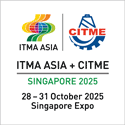Farzana Alam Piya, Research Assistant, Textile Focus
Generally cotton fabric and polyester fabric are colored using synthetic dyes. But dyeing cotton is a more water- and heat-intensive process. As the surface of cotton fibers is negatively charged, it doesn’t react with negatively charged dye compounds easily. Even with an assist from salts and alkali added to the dye solution, cotton takes up only about 75% of the dye. To ensure the colorfastness, dyed fabric or yarn is washed over and over again in hot water, creating large amounts of wastewater. Around 200 L of water is used to produce 1 kg of fabric.

As cotton is consumers’ most favorite fiber with an always accretive demand, continuous researches are taking place to reduce the cost of dyeing cotton as well as the use of water and energy.
An American company named Huntsman has developed a line of dyes for cotton called Avitera that bonds to the fiber directly and require ¼ to 1/3 less water and 1/3 less energy. Three reactive groups are attached to the dye formula’s chromophore or color-providing molecule—compared with the one or two reactive groups common for cotton dyes. Because of the extra reactive groups, the dye step lasts about four hours, compared with seven hours for conventional dyes. This method is cost saving as it is reducing the use of energy and water.
Another way to improve the bond between dyes and cotton fibers is a process called Cationization. ColorZen, a start-up in North Carolina, has developed a cotton pretreatment step where Tony Leonard is the inventor and technical director. Leonard said, “With conventional cotton dyeing, salt is used to negate the charge on the surface of the cotton. But ColorZen technology uses a quaternary ammonium compound to permanently attach a positively charged amino site on the cellulose molecule that makes a natural attraction between dye and fiber.” ColorZen treats raw cotton fiber right from the field removing the seeds. After the treatment, cotton is spun into yarn for customer facilities. Leonard assured that ColorZen’s pretreatment makes the dyeing process faster while using 90% less water, 75% less energy, 90% fewer auxiliary chemicals and also cuts out almost half the dye compared with processes of using salts in dyeing bath.
In case of washing dyed cotton, huge amount of water is needed to remove unfixed dye, compared to other fabrics. On the other hand according to some calculations, 100 kg of petroleum, 1,000 L of water and 10 kg of other chemicals are needed to produce 1 kg of dye. Instead of dyes, pigments can be used for coloring the cotton.
Digital textile printing is becoming more familiar day by day. For polyester digital printing, a two-step dye sublimation process is used which is almost waterless. But this process doesn’t work for cotton, silk or other natural fabrics. Intech Digital, a company that produces printers, print-heads and inks for textiles, offers a new specialty of ink made with powdered, insoluble pigments plus a polymer-like binder designed to make the color stick. Using this ink, only is a printer and a heat system (to fix the ink) is needed and this process can be done anywhere without the environmental concerns or any cost of managing wastewater.
The textile industry is highly competitive, and in the end what matters is cost. So, innovators with greener dyeing technology needs to work harder to keep their progress from unraveling.
Reference:
Chemical & Engineering News, ISSN 0009-2347, Copyright © 2019 American Chemical Society






